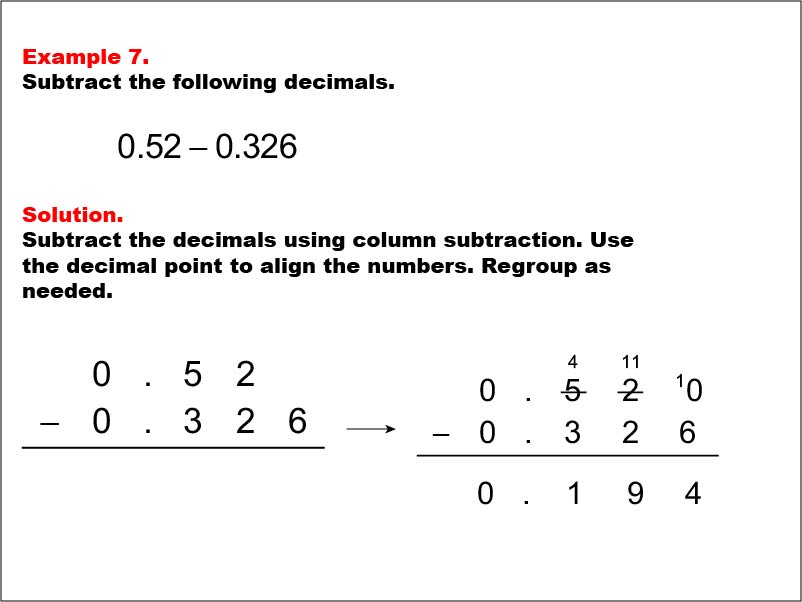
Display Title
Math Example--Decimal Concepts--Subtracting Decimals: Example 7
Display Title
Math Example--Decimal Concepts--Subtracting Decimals: Example 7

Topic
Decimals
Description
This example demonstrates the process of subtracting decimals with different numbers of decimal places. The problem presented is 0.52 - 0.326. The solution involves aligning the decimal points, adding zeros as placeholders, and performing column subtraction with regrouping in the hundredths place. By following this method, students can solve the problem step-by-step and arrive at the correct answer of 0.194.
Subtracting decimals with different numbers of decimal places is a crucial skill in mathematics that builds upon students' understanding of place value, basic arithmetic operations, and the concept of regrouping. This collection of examples helps teach the topic by providing clear, visual representations of the subtraction process, including cases where zeros need to be added as placeholders and regrouping is necessary. Students can observe how to align decimal points, add zeros when needed, and perform the subtraction column by column.
Presenting multiple worked-out examples is essential for students to fully grasp the concept of decimal subtraction, especially when dealing with numbers that have different numbers of decimal places. Each example in this collection showcases different scenarios, helping students develop a comprehensive understanding of the process and gain confidence in their ability to subtract decimals accurately, even when the numbers don't have the same number of decimal places.
Teacher's Script: Now, let's look at our seventh example of subtracting decimals, which involves numbers with different decimal places. We have 0.52 minus 0.326. First, let's align the decimal points and add a zero to 0.52 to make it 0.520. This doesn't change its value, but it helps us line up our place values. Starting from the right, we have 0 thousandths minus 6 thousandths, which we can't do. So, we need to regroup. We borrow 1 hundredth from the 2 hundredths, making it 1 hundredth, and add 10 thousandths to our 0 thousandths, making it 10 thousandths. Now we can subtract: 10 thousandths minus 6 thousandths equals 4 thousandths. Moving to the hundredths column, we now have 1 hundredth minus 2 hundredths, which we can't do. So, we borrow 1 tenth from the 5 tenths, making it 4 tenths, and add 10 hundredths to our 1 hundredth, making it 11 hundredths. 11 hundredths minus 2 hundredths equals 9 hundredths. Finally, in the tenths column, 4 tenths minus 3 tenths equals 1 tenth. So, our final answer is 0.194. Remember, when subtracting decimals with different numbers of decimal places, always align the decimal points and add zeros as placeholders when necessary!
For a complete collection of math examples related to Subtract Decimals click on this link: Math Examples: Subtracting Decimals Collection.
| Common Core Standards | CCSS.MATH.CONTENT.5.NBT.B.7, CCSS.MATH.CONTENT.6.NS.B.3 |
|---|---|
| Grade Range | 4 - 6 |
| Curriculum Nodes |
Arithmetic • Decimals • Add and Subtract Decimals |
| Copyright Year | 2013 |
| Keywords | tutorials, subtracting decimals, tenths, hundredths |